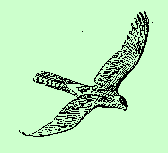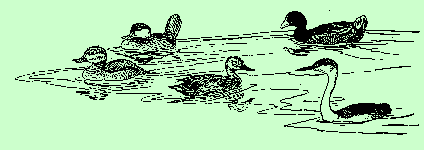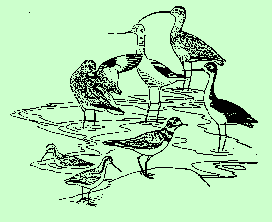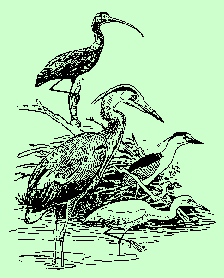|
WHY VALUE THIS MARSH?
by Leah T.Foerster

 There are more than seven miles of dikes that can be hiked at Farmington Bay
during the winter months. Although myriad forms of life lie dormant under
the ice and snow, the survival of over-wintering birds and animals at the
marsh is a matter of striking odds. In February, before there were any
significant signs of spring, I began such a hike.
There are more than seven miles of dikes that can be hiked at Farmington Bay
during the winter months. Although myriad forms of life lie dormant under
the ice and snow, the survival of over-wintering birds and animals at the
marsh is a matter of striking odds. In February, before there were any
significant signs of spring, I began such a hike.
February 1, 1976

 Beyond the first bend in the road after crossing Farmington Creek, a marsh
hawk hovered and dropped repeatedly into patches of tall wheatgrass, only
to rise up again with nothing in its talons. Then suddenly a hen pheasant
exploded from the grass. In a burst of speed that outdistanced the hawk, the
hen flew over the fence to hide in the sagebrush. A cluster of pheasant
feathers caught in bushes further along the road was evidence that one had
not escaped its hunter.
Beyond the first bend in the road after crossing Farmington Creek, a marsh
hawk hovered and dropped repeatedly into patches of tall wheatgrass, only
to rise up again with nothing in its talons. Then suddenly a hen pheasant
exploded from the grass. In a burst of speed that outdistanced the hawk, the
hen flew over the fence to hide in the sagebrush. A cluster of pheasant
feathers caught in bushes further along the road was evidence that one had
not escaped its hunter.


 Miniature bear-like footprints of a skunk that meandered for some distance
onto the ice-covered Bay came to an abrupt end with some signs of a scuffle.
Perhaps a golden eagle like the one circling above had swooped on the skunk
that was still a bit groggy from winter napping.
Miniature bear-like footprints of a skunk that meandered for some distance
onto the ice-covered Bay came to an abrupt end with some signs of a scuffle.
Perhaps a golden eagle like the one circling above had swooped on the skunk
that was still a bit groggy from winter napping.

 From under the spillway and a few feet beyond, the ice had given way. White
patches on the head of a lively little bufflehead winked like a light as it
dived and surfaced in the running water. A small flock of ruddy ducks, their
fan-shaped tails still drooped, swam and dived in the company of mergansers,
eared grebes, coots, and shovelers. A mallard hen rested alongside the cement
arm of the spillway. She limped to the water with her injured leg and swam
away to safety.
From under the spillway and a few feet beyond, the ice had given way. White
patches on the head of a lively little bufflehead winked like a light as it
dived and surfaced in the running water. A small flock of ruddy ducks, their
fan-shaped tails still drooped, swam and dived in the company of mergansers,
eared grebes, coots, and shovelers. A mallard hen rested alongside the cement
arm of the spillway. She limped to the water with her injured leg and swam
away to safety.


 Beyond the spillway, a whistling swan, its snowy-white body propped on one
of its long black thin legs, and head tucked under the wings with only the
black tip of its beak showing, slept on the ice.
Beyond the spillway, a whistling swan, its snowy-white body propped on one
of its long black thin legs, and head tucked under the wings with only the
black tip of its beak showing, slept on the ice.
February 22

 Cracks in the ice had spread apart as time added minutes of daylight. A flock
of more than 3,000 widgeons and common goldeneyes had arrived from Southern
Utah to join the over-wintering pintails and shovelers in sharing the bounty
of food released from the Bay's deep freeze. The whistling of the goldeneyes
in flight, and that of the pintails, was a contrast to the "woofing" sound
of wings as the noisy shovelers suddenly took flight.
Cracks in the ice had spread apart as time added minutes of daylight. A flock
of more than 3,000 widgeons and common goldeneyes had arrived from Southern
Utah to join the over-wintering pintails and shovelers in sharing the bounty
of food released from the Bay's deep freeze. The whistling of the goldeneyes
in flight, and that of the pintails, was a contrast to the "woofing" sound
of wings as the noisy shovelers suddenly took flight.


 A yellow-headed blackbird, his head and neck the orange-red color of an
oriole, flew in amiable company with a flock of redwings. As they perched
atop the ragged spears of cattails, the harsh call of the yellow-head was
not so gleeful as that of the redwings. Goldfinches, twenty-three of them,
were resting in a Russian olive tree. Their twitterings, and sometimes a
phrase of song, are as subdued as their pale yellow feathers.
A yellow-headed blackbird, his head and neck the orange-red color of an
oriole, flew in amiable company with a flock of redwings. As they perched
atop the ragged spears of cattails, the harsh call of the yellow-head was
not so gleeful as that of the redwings. Goldfinches, twenty-three of them,
were resting in a Russian olive tree. Their twitterings, and sometimes a
phrase of song, are as subdued as their pale yellow feathers.

 From the damp floor of its jungle of dead bulrush stems, a diminutive brown
bird gave voice to its presence. It flew up to cling for a second to a
bulrush stem, cocking its tail saucily, then with alternate scolding,
bubbling trilling notes, disappeared. A persistent little bird, the
long-billed marsh wren seemed to ardently praise its habitat day and night.
From the damp floor of its jungle of dead bulrush stems, a diminutive brown
bird gave voice to its presence. It flew up to cling for a second to a
bulrush stem, cocking its tail saucily, then with alternate scolding,
bubbling trilling notes, disappeared. A persistent little bird, the
long-billed marsh wren seemed to ardently praise its habitat day and night.
February 27

 A few avocets, the first of their species to arrive at the Bay this year,
swept the muck on an open area of mudflat with their long thin upturned
bills. A flush of cinnamon color was beginning to replace the dull gray
winter plumage of their heads and necks. Four large sandpipers, their
plumage still dull gray and white, balanced gracefully on their long yellow
legs as they, too, probed the mudflats for crustaceans, worms, or larvae.
A few avocets, the first of their species to arrive at the Bay this year,
swept the muck on an open area of mudflat with their long thin upturned
bills. A flush of cinnamon color was beginning to replace the dull gray
winter plumage of their heads and necks. Four large sandpipers, their
plumage still dull gray and white, balanced gracefully on their long yellow
legs as they, too, probed the mudflats for crustaceans, worms, or larvae.


 On scattered piles of ice and snow toward the east shore of the Bay, eleven
golden eagles rested in groups of two or three. Their dark bodies reflected
on the ice loomed large, and the golden sheen of their hackles celebrated
their identity. Ducks that blackened the open waters kept a respectful
distance.
On scattered piles of ice and snow toward the east shore of the Bay, eleven
golden eagles rested in groups of two or three. Their dark bodies reflected
on the ice loomed large, and the golden sheen of their hackles celebrated
their identity. Ducks that blackened the open waters kept a respectful
distance.

 A teal flew up, its underwings blue and the crescent on its cheeks pure white.
In the moment spent admiring the almost porcelain beauty of the blue-winged
teal, nine of the eagles had silently disappeared. The two remaining soon
took flight. Flocks of green-winged teal, and a few cinnamon teal drakes,
along with mallards, redheads, and shovelers, almost immediately moved into
the area vacated by the eagles.
A teal flew up, its underwings blue and the crescent on its cheeks pure white.
In the moment spent admiring the almost porcelain beauty of the blue-winged
teal, nine of the eagles had silently disappeared. The two remaining soon
took flight. Flocks of green-winged teal, and a few cinnamon teal drakes,
along with mallards, redheads, and shovelers, almost immediately moved into
the area vacated by the eagles.


 Along the dike that curved toward the New State Duck Club, a pair of sage
thrashers, running in and out among the withered plants with their dark
tails uptilted, looked almost like chipmunks. The song of the sage thrasher,
which I heard last spring, was like the casual whistling notes of a boy.
Along the dike that curved toward the New State Duck Club, a pair of sage
thrashers, running in and out among the withered plants with their dark
tails uptilted, looked almost like chipmunks. The song of the sage thrasher,
which I heard last spring, was like the casual whistling notes of a boy.

 On returning from this day's hike, the dikes were muddy and mushy from the
melting of snow. At Farmington Creek, the flight of a black broadwinged hawk
with a brownish tail caught my eye. It alighted in a tall willow tree. With
the aid of my binoculars, I identified it to be the melanistic red-tailed
hawk that Tim Provan, Superintendent of the Area, had alerted me to watch for
that day. Through the branches of the leafless tree where the sun shone on
the hawk, the color of its plumage was actually an extremely dark brown. The
hawk had come to roost in the tree for the night.
On returning from this day's hike, the dikes were muddy and mushy from the
melting of snow. At Farmington Creek, the flight of a black broadwinged hawk
with a brownish tail caught my eye. It alighted in a tall willow tree. With
the aid of my binoculars, I identified it to be the melanistic red-tailed
hawk that Tim Provan, Superintendent of the Area, had alerted me to watch for
that day. Through the branches of the leafless tree where the sun shone on
the hawk, the color of its plumage was actually an extremely dark brown. The
hawk had come to roost in the tree for the night.

 For a fleeting time as I watched this rare and beautiful phase of this
species, I too enjoyed the sanctuary of this ever interesting marsh.
For a fleeting time as I watched this rare and beautiful phase of this
species, I too enjoyed the sanctuary of this ever interesting marsh.

Illustrations from U.S. Fish and Wildlife Service
|
|
![]()
![]() Beyond the first bend in the road after crossing Farmington Creek, a marsh
hawk hovered and dropped repeatedly into patches of tall wheatgrass, only
to rise up again with nothing in its talons. Then suddenly a hen pheasant
exploded from the grass. In a burst of speed that outdistanced the hawk, the
hen flew over the fence to hide in the sagebrush. A cluster of pheasant
feathers caught in bushes further along the road was evidence that one had
not escaped its hunter.
Beyond the first bend in the road after crossing Farmington Creek, a marsh
hawk hovered and dropped repeatedly into patches of tall wheatgrass, only
to rise up again with nothing in its talons. Then suddenly a hen pheasant
exploded from the grass. In a burst of speed that outdistanced the hawk, the
hen flew over the fence to hide in the sagebrush. A cluster of pheasant
feathers caught in bushes further along the road was evidence that one had
not escaped its hunter.


![]()
![]() Cracks in the ice had spread apart as time added minutes of daylight. A flock
of more than 3,000 widgeons and common goldeneyes had arrived from Southern
Utah to join the over-wintering pintails and shovelers in sharing the bounty
of food released from the Bay's deep freeze. The whistling of the goldeneyes
in flight, and that of the pintails, was a contrast to the "woofing" sound
of wings as the noisy shovelers suddenly took flight.
Cracks in the ice had spread apart as time added minutes of daylight. A flock
of more than 3,000 widgeons and common goldeneyes had arrived from Southern
Utah to join the over-wintering pintails and shovelers in sharing the bounty
of food released from the Bay's deep freeze. The whistling of the goldeneyes
in flight, and that of the pintails, was a contrast to the "woofing" sound
of wings as the noisy shovelers suddenly took flight.

![]()
![]() A few avocets, the first of their species to arrive at the Bay this year,
swept the muck on an open area of mudflat with their long thin upturned
bills. A flush of cinnamon color was beginning to replace the dull gray
winter plumage of their heads and necks. Four large sandpipers, their
plumage still dull gray and white, balanced gracefully on their long yellow
legs as they, too, probed the mudflats for crustaceans, worms, or larvae.
A few avocets, the first of their species to arrive at the Bay this year,
swept the muck on an open area of mudflat with their long thin upturned
bills. A flush of cinnamon color was beginning to replace the dull gray
winter plumage of their heads and necks. Four large sandpipers, their
plumage still dull gray and white, balanced gracefully on their long yellow
legs as they, too, probed the mudflats for crustaceans, worms, or larvae.


